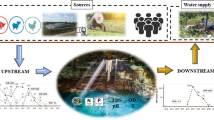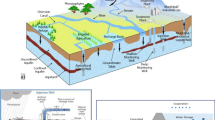Abstract
Southeast South Australia has large reserves of potable groundwater, generally close to the surface. European settlement has had a major impact on groundwater quality due to the presence of extensive karst in the unconfined aquifer. Historically, industries such as cheese factories were often sited close to karst features (e.g. caves and sinkholes) because they provided a convenient means of waste disposal. Although most have long since closed, they have left a legacy of pollution plumes of varying sizes. In Mount Gambier, the main regional centre, the presence of both exposed and subterranean karst features provided a “perfect system” for the disposal of stormwater. Prior to the provision of a sewerage system within Mount Gambier, all toilet and household wastewaters were disposed to ground. These activities and the subsequent problems that began emerging in the 1960s have led to a concerted effort over the last 20 years to change the philosophy of waste disposal and to generate an understanding and responsibility by those who live in the region and depend on groundwater for the major part of their water supply. Mount Gambier's water supply comes from the Blue Lake. Groundwater inflow from a highly karstic Tertiary limestone aquifer provides 90% of the recharge to the Blue Lake. The lake is a high-value resource in a high-risk environment and in order to minimize this risk, a water-quality management plan for the lake is currently being developed.
Similar content being viewed by others
References
Allison GB and Harvey PD (1983) Freshwater lakes. In: Tyler MJ, Twidale C, Ling JK, Holmes JW (Eds),Natural History of the South East, [city:] Royal Society of South Australia, Adelaide
Emmett AJ (1985)Mount Gambier stormwater quality. EWS Library Reference 84/23
EWS (Engineering and Water Supply Department) (1973)Report of the committee on water pollution control in the South East. Engineering and Water Supply Department. Library Reference 73/15
Jennings JN (1985)Karst geomorphology. [city:] Basil Blackwell. pp 23–24
McDonald MG and Harbaugh AW (1988)A modular threedimensional finite-difference ground-water flow model. Techniques of water resources investigations of the United States Geological Survey open File Rep. Washington, D.C., pp. 83–875
Schrale G, Smith PC, and Emmett AJ (1984)Limiting factors for land treatment of cheese factory waste in the Mount Gambier area, South Australia. Aust Water Wastewater Assoc J Water 11:10–14
Smith PC and Schrale G (1982)Proposed rehabilitation of an aquifer contaminated with cheese factory wastes. Aust Water Wastewater Assoc J water March 1982, 9:21–24
Telfer AL (1993)Groundwater resource management and community consultation—Blue Lake, South Australia. Australian Geological Survey Organisation. Aust Geol Geophy, 14(2):201–206
Waterhouse JD (1977)The hydrogeology of the Mount Gambier area. Report of Investigations of the Geological Survey of South Australia 48, Adelaide
Author information
Authors and Affiliations
Rights and permissions
About this article
Cite this article
Emmett, A.J., Telfer, A.L. Influence of karst hydrology on water quality management in southeast South Australia. Geo 23, 149–155 (1994). https://doi.org/10.1007/BF00766988
Received:
Accepted:
Issue Date:
DOI: https://doi.org/10.1007/BF00766988




